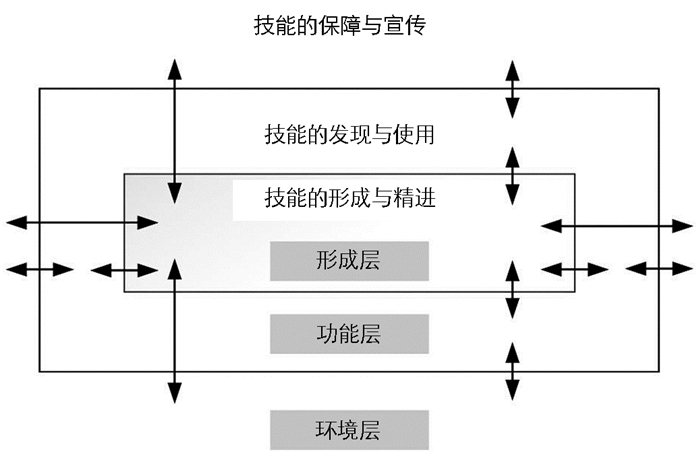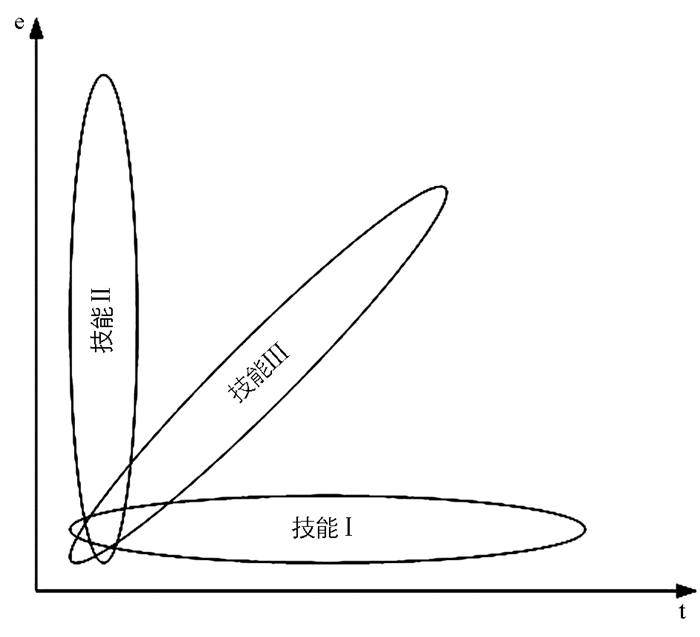-
“增强职业技术教育适应性”成为近年来政策文本中的热词,无论是《中共中央关于制定国民经济和社会发展第十四个五年规划和二〇三五年远景目标的建议》,还是习近平总书记对职业教育工作的最新指示中,都将增强职业技术教育适应性视为下一阶段我国职业教育发展的重要任务。然而,职业教育适应经济社会发展的相关要求早已在1985年的《中共中央关于教育体制改革的决定》中有所体现。三十余年来,已有的研究成果大多聚焦职业教育与产业间的适应性,从人才结构[1]、专业结构[2]、院校结构[3]等层面分析了职业技术教育适应性水平。但是,尚未有研究对“增强职业技术教育适应性”这一命题进行理论溯源,也缺乏职业教育与经济社会发展其他维度互动的研究视角。我们应该如何理解“职业技术教育适应性”的本质?在构建技能型社会的新背景下,这种适应性有何新的内涵和特征?如何增强职业教育的适应性?这些问题亟待系统解答。
全文HTML
-
职业技术教育适应性问题看似是职业教育与经济社会发展间的互动问题,本质上却根源于技能作为职业教育核心要素的复杂性,尤其是技能问题天然的社会属性,深度形塑了职业教育的适应性。
-
技能大多具有个体性,是智力与体力的融合。长期以来,技能短缺、技能失配等问题被局限于教育领域,从专家学者到政府官员,试图通过不断完善技能教育的各个环节,实现个体层面的技能提升,进而实现技能供给与需求侧的对接。较为典型的便是职业教育与培训课程开发范式上的演进,包括能力本位课程、MES课程、学习领域课程等在内的不同课程开发范式[4],均强调要通过改革学校教育促进技能供需间的衔接和匹配,从而提升技能形成的效率。但是从世界各国技能形成发展的历程来看,技能问题并非天然带有教育属性,仅仅是教育层面的方案也难以解决一国技能的供给、使用和更新问题。“更好的技能形成系统会导致更好的经济表现”的假设也并不能得到证据的完全支持,因为它忽视了几个制度因素的复杂相互作用,包括劳动力市场监管、就业结构、金融系统和企业内部的权力关系[5]。技能首先是一个社会问题。
技能问题的社会属性源自两个方面。一方面,技能超出了个体行动层面的含义,与社会运转高度关联,受到国民教育系统与生产系统的共同牵制[6]。因为技能作为一种人力资本的存在形式,需要通过特定的形式生产、传播和使用。人类社会曾通过试误、实验、想象、训练等多种方式探索和形成技能,以学徒制、学校教育等形式传播技能,并通过不同类型的劳资关系与生产组织方式使用和管理技能。生产技术的进步、生产关系的演变、社会形态的更迭,都形塑着技能的形成和使用。在技能逐渐专有化和高移化的当下,这种影响日益固化,并渗透到了社会运行的机理之中。例如马克思曾长期关注机械化、自动化导致的“去技能化”对劳动控制权和不同社会阶层的影响[7],西伦曾通过对德国、英国、美国和日本的技能形成历史的分析,发现了技能形成过程中的制度演化,将技能形成的过程描述为一个“社会建构”的过程[8]; 英国卡迪夫大学的布朗教授引入了“社会压力点”这一概念,通过分析德国、英国、新加坡和韩国技能形成体系的演进历史,发现了社会与经济变革对技能的形成与使用所产生的根本影响[9]。近年来,中国社会发展进程中的技能形成与使用制度的变革也进入了研究者的视野,新中国成立以来工厂师徒制的演变[10]、技能人才的社会流动[11]等主题也都印证了社会主义社会形态下技能问题的独特性和复杂性,“技能社会学”作为学科分支领域也开始得到系统性的论述[12]。
另一方面,技能在其演进过程中与政治体系、经济体系、社会体系等形成特定的互动机制,高度形塑着社会发展的过程。这是因为技能本质上是人类生产生活的基本要素,从单纯地依靠技能谋生,到凭借独占技能把握行业话语权,技能以改变个体的行动和思维、提升社会生产力、影响社会群体的权力格局等形式,深度影响着个体的生存质量与方式,社会的运转乃至国家和世界的发展格局。例如有研究显示,个体技能的专有化程度会影响其是否支持退出欧盟[13]; 技能在生产实践中的形态、分布和传播机制决定了劳动者和管理者在生产控制竞争中的话语权[14]。为了创造高技能经济体,政府应该实施一系列包括政治、社会和经济改革在内的一揽子改革计划[15]。
-
正是因为技能与社会间独特的互动机制与融合方式,任何一个技能问题都天然具有一定的社会属性。技能问题的解决,也必须要考虑社会作为人类生活共同体所暗含的系统性和综合性。这种思想可以最早追溯到《国富论》对技术水平、工作组织和生产率的系统性观察与描述。进入20世纪80年代,技能与国家经济表现之间关系的文献日益增多,且这些文献大都拥有一个共同的政策指向,即只有政治、经济、社会等不同领域的综合改革和政策组合,才能创建高技能、高工资的经济体,仅仅提升技能水平是不够的[16]。基于此,学界提出了“技能生态”(skill ecosystem)这一概念,通过引入生态学中的“有机与动态关系”理论,以阐释不同地区内部所形成的技能关系网络。Finegold首次将“技能生态”定义为“在一定区域或部门内,以生产目的开发和部署人类技能的社会形态(society formation)”[17],这一社会形态包含商业环境和相关的商业模式、制度/政策框架、劳动模式、工作结构以及技能水平和形成体系等多个要素。这一定义将技能视为影响社会存在与发展的基本要素,强调围绕技能构建社会的运行机制和发展模式,从而最终构建有助于技能形成、传播和使用的社会形态。
自本世纪初期起,美国、澳大利亚、英国、新西兰等老牌资本主义国家围绕“技能生态”的构想,相继开展了数百个项目的探索[18]。这些试点项目持续了十余年,并很大程度上影响了这些国家的技能政策[19]。总的来看,不同国家围绕“技能生态”所开展的探索主要得出了以下几个结论:首先,技能生态系统的关键在于如何权衡不同利益主体围绕技能的形成、使用和传播所形成的复杂关系,尤其是作为技能供给主体的学校,与技能需求主体的企业之间的互动机制,以及政府、行业、社会组织所扮演的协调作用; 其次,技能生态系统具有显著的地域性和多样性。不同的国家,甚至同一个国家内的不同地区围绕技能的供需,可以形成不同类型的生态体系,这取决于区域内的制度同构性、产业异质性等因素; 再次,强调技能生态,并非否定技能教育的意义。相反,“技能生态”概念的提出正是为了提升技能教育的效率。传统的技能短缺治理过度聚焦技能的供给,尤其是供给的数量,忽略了技能供给的质量及其使用的状态,同时缺乏技能供给的前瞻性。如果技能人才在社会上无法获得应有的社会地位,技能的社会价值没有得到充分的挖掘,面向未来的技能无法得到前瞻性地开拓和培养,那么即便技能教育的产出再多,技能浪费、技能失衡、技能短缺等现象将无法得到根本解决。最后,构建技能生态,并非否认政府在制度建构中的价值与能动性。事实上,正是因为技能问题的社会属性,为政府有所作为提供了操作的空间。技能所附带的政治权力、社会地位、专业话语权、生产效率等深度影响着人类社会的发展,政府在技能问题中的介入,既是提升技能生产、使用、传播与创新效率的需要,也是平衡社会主体权力、维护社会基本制度、塑造不同市场经济体生产模式的需要[10]。
因此,职业教育的适应性问题,并不仅仅是职业教育内部的调整行为,也不是职业教育被动适应外部环境的过程,而是要以技能为要素,深度嵌入社会制度环境并与各子系统互动[20],并逐渐形成一个有利于技能形成、发现和使用的生态系统。对于不同国家而言,增强职业技术教育适应性要求各国探索基于本国政治体制、经济体制、产业特征、社会形态和文化特质的技能生态系统。
一. 技能问题的社会属性
二. 技能形成的社会嵌入
-
改革开放后,我国逐渐由高度集中的计划经济体制,向计划经济为主、市场经济为辅的经济体制转变。1992年中国共产党第十四次全国代表大会确立了“建立社会主义市场经济体制”的改革目标,自此我国走上了有中国特色市场经济的发展道路。经济体制改革属于生产关系的变革,是适应生产力发展的改革举措。在生产关系适应生产力改革的过程中,我国的产业特征、社会形态、文化特质、治理模式等都在不断发生相应变化。因此,尽管“职业教育适应经济社会发展”的命题始终存在,但其内涵却随着经济体制、政治体制、文化体制等领域的改革而不断蜕变和完善。这一变化的基本趋势是从“被动适应”走向“主动调适”。
-
计划经济时期,国家经济发展实行高度集中的计划发展模式,由政府对生产、资源分配以及产品消费事先进行指令性计划,并按照计划开展经济活动。这种经济体制及发展模式在一定程度上为职业教育提供了融入企业生产的制度环境,“校办工厂”“厂办技校”“八级工制度”等都是这一时期职业教育嵌入经济社会发展的典型模式。然而,计划经济体制决定了职业教育的发展主要受制于政府经济发展方向下的人才需求结构,较为僵化的人才供需机制也难以释放职业教育的发展潜力。1992年中共中央确立市场经济体制改革的基本目标,开启了我国市场经济改革的序幕。这其中,剥离企业的非生产经营业务、大力推进国有企业市场化改革成为影响职业教育发展的关键因素。职业教育逐渐失去了计划经济时期“政府包办一切”的制度土壤,开始逐渐被市场化的思想所形塑。然而,尽管市场经济体制改革已然推进,但是计划经济思维的存在,使得职业教育仍然秉持着过去被动适应经济社会需求的发展模式。这种“被动适应”主要体现在以下几个方面:
-
计划经济时期的制度特征,使职业教育能够以社会子系统的角色嵌入经济社会发展的大局之中,以国有企业为典型代表的“单位制”,形成了地域乃至全国范围内的技能形成、使用和发展的生态系统。市场经济体制改革,改变了过去技能形成和使用的社会生态,使职业教育逐渐淡化了其社会属性,而不断强化其教育属性。从优化资源配置的角度来看,这一改革是必要的。但是它也很大程度上掩盖了技能形成问题的复杂性。产业转型升级带来的企业对高级技能、知识技能、专有技能的需求,不仅仅是技能形成环节需要解决的矛盾,更需要技能使用、保护和发展环节的积极参与。而“被动适应”的发展模式,使很多问题的思考被局限于教育的视角,从而影响了技能问题的统筹解决。
-
市场经济体制改革使得企业的非生产性功能(包括教育功能)逐渐式微,且职业院校大多收归教育部门管理,其办学的行业属性淡化乃至消失[21]。这就要求职业教育必须要在市场化的环境下加强产教融合、校企合作,主动对接产业界的人才培养、技术研发等实际需求。教育部门提出了“专业与产业、职业岗位对接,专业课程内容与职业标准对接,教学过程与生产过程对接,学历证书与职业资格证书对接,职业教育与终身学习对接”的五对接模式,正是职业教育在新环境下试图打开新发展局面的尝试。然而,对接产业仅仅解决了职业教育适应过去或当下发展的需求,而企业技术水平的迭代,以及生产组织方式的不断革新,无法及时有效地传导到教育系统之中。学校作为教育组织内部同样也具有制度变革的“路径依赖”,对新事物的接纳和制度化需要一定的过程。这就导致了职业教育产教融合、校企合作曾长期出现“校热企冷”的现象,甚至校企合作演变为学校向企业输出廉价劳动力的经济行为。因此,“被动适应”下的职业教育缺乏前瞻性、创造力和共同体理念的发展观,影响了职业教育提升人力资本的社会认可度。
-
长期以来,职业教育并未被视为一种教育类型,没有自下而上的完整体系。因此,职业教育只能被动适应学术教育的内容、模式及其人才评价机制,以“低层次教育”“差生教育”的社会标签存在于普通教育体系之中。这压制了职业教育自身发展的动力源,模糊了职业教育培养应用型人才的发展定位。尽管21世纪初职业教育借助“骨干校”“示范校”等项目开启了发展模式的探索,但是在内部上升通道不畅、普通高考指挥棒效应显著、强调学历作为人力资本信号作用的社会中,职业教育始终面临着艰难被动的发展局面。
-
“被动适应”的局面在近年来党中央、国务院的一系列决策部署中得到扭转,对职业技术教育适应性的认识开始由“被动适应”向“主动调适”过渡。“主动调适”强调职业教育作为社会子系统与外部制度环境的互动和动态匹配,以及职业教育系统内部的自我优化,其目的是构建一个“国家重视技能、社会崇尚技能、人人想学技能”的技能型社会。在这一社会环境中,职业教育不再是技能问题解决过程中的“孤岛”,而是深度参与技能供需调节、技能生态治理、技能人才发展的主体。职业教育“主动调适”体现在以下几个方面:
-
确立职业教育作为一种教育类型的重要地位,是职业教育由“被动适应”走向“主动调适”的基础。只有建立起纵向贯通、横向融通的现代职业教育体系,建立起体现应用型人才特征的评价机制和质量控制机制,才能凭借应用型人才的系统化培养和输送,拥有参与技能社会治理、影响产业布局、迎接未来竞争的载体和实力。“十三五”期间,我国确立了职业教育的类型地位,并初步建成现代职教体系,尤其是在职教本科的举办上取得了历史性的突破,这为“十四五”时期职业教育以主动调适的姿态参与技能型社会的建设奠定了基础。
-
与过去职业教育单向度地参与经济社会发展不同,“主动调适”强调嵌入式的发展。“制度的嵌入性”最早由波兰尼提出,并由格兰诺维特在《作为社会结构的经济制度:分析框架》一文中得到进一步阐述,它强调人的理性选择总是在各种约束中的选择,这种“嵌入性”的本质就是选择行为的制度约束[22]。很多技能形成的问题并非仅仅是教育层面的问题,技能的社会评价、技能作为生产要素的社会价值、技能人才的发展通道等非教育因素,从不同角度深度影响着技能的形成方式、速度和质量。在有些时候,技能的形成反而并不是最关键的因素,因为技能形成的主体——人是在一个复杂的制度环境下生存的,其做出的理性选择必然受到不同约束条件的制约。一味地强调教育与培训,单纯地强调技能的高质量供给,可能并不能解决技能供需失配、动力不足等问题。因此,职业教育要深度嵌入经济社会发展环境中,教育制度的变革,必须要匹配人事制度、评价制度、宣传体系、激励体系等的变革,在社会建构的过程中实现制度的匹配。
-
职业教育的主动适应,还应体现在对技术技能人才的前瞻性供给,以及为职业教育学习者提供前瞻性技能两个方面。从产业的角度来看,职业教育应建立面向当下产业需求的职业能力教育体系,和面向未来发展需求的创新教育体系,尤其是鼓励教师和学生,基于当下的企业技术难题和市场需求开展技术改良或革新,培养拥有适应人工智能生产模式、敏锐捕捉创新要素和市场变化的新产业工人。从人民群众的角度来看,职业教育除了要做好面向职业的教育之外,更要强化面向生涯的教育,注重学生核心能力的培养与评价,并为学生进入更高层次的教育、接受更高质量的教育提供条件。
一. 职业教育的“被动适应”
1. 问题域的局限:社会问题被当作教育问题对待
2. 发展观的困境:被动适应产业需求的滞后发展
3. 动力源的缺失:在普通教育的体系中寻找层次定位
二. 职业教育的“主动调适”
1. 类型定位:在类型教育中建构内部体系
2. 社会嵌入:与经济社会发展环境的双向互动与支撑
3. 前瞻设计:面向产业和人民群众对教育需求的前瞻性
-
可以看出,从“被动适应”到“主动调适”,增强职业教育的适应性不仅仅是职业教育内部的体系化和面向未来的变革,更需要外部制度环境的支撑和保障,以实现“技能型社会”的建设愿景。基于此,增强职业技术教育适应性应以解决技能问题为突破口,将技能问题置于复杂的社会背景之中,从技能的形成、使用、发展三个环节入手,遵循技能形成层、技能功能层和技能环境层相互影响和嵌套的行动框架(图 1)。
-
“技能形成层”是增强职业技术教育适应性的核心内容,也是实现技能从无到有、从有到优的环节。它的目的是通过技能人才的培养,促进全社会技能的形成、更新、精进乃至创新。王彦军根据技能与时间的关系,将技能形成分为三种类型(图 2):技能I属于最为基础的技能类型,主要依靠身体素质和体力劳动的付出,因此随着时间的提升,其技能水平很难随着时间的推移而提升,主要是通过医疗保障、饮食水平提升、基本生存技能传授等方式维持; 技能II属于中低层次的技能。这类技能通过中短期的职业教育和培训即可获得,但由于技能本身的复杂度不高、专有性特征弱,因此随着时间的推移难以获得更大的提升; 技能III属于“知识性技能”,是较为复杂且具有发展潜力的技能。这类技能需要通过连续的职业教育与技能培训方可获得,且对组织的依赖性较高,企业专有性人力资本特征较强,需要在实践过程中不断地打磨和精进,从而不断实现熟练度和创新度上的突破[23]。此外,关乎学习者未来发展和产业升级的核心能力和前瞻性技能也属于此类。
-
基于上述技能的分类,“技能形成层”中涉及的社会行为主要包括三类:一是制度化的教育与培训。基于良构问题情境的学校职业教育,与基于非良构问题情境的工作场所职业教育构成了制度化技能形成的两大主要方式。目前这两大方式日益走向融合,以“双元制”“现代学徒制”“新型学徒制”等为代表的技术技能人才培养模式在现代技能开发的过程中扮演着日益重要的作用。职前教育和职后培训之间也逐渐由断裂走向一体化设计,形成终身技能形成与精进体系[24]。二是自发性的工作场所学习、促进民间传统技艺传承的师徒制、社会公众基本生存与互助技能的传播等非制度化的技能形成行为,这些行为在特殊技能、基本生存技能的开发和形成中发挥不可替代的功能。三是企业内部的技术技能知识管理、行业内的技能协作与创新等组织、制度层面的技能形成行为。
-
诸多社会主体围绕“技能的形成与精进”这一目标形成了特定的社会功能和协作关系。各级各类职业院校和培训机构在技能形成的过程中发挥奠基作用。它们通过理论知识的教学和技能的训练,实现个体对技能的深入理解与熟练操作。行业、企业为技能的形成与精进提供了情境、灵感、目标和动力,让技能形成的结果能够得到实践的检验。构建现代职业教育体系和终身职业技能培训制度的目的,就是为了让学校和企业之间围绕技能人才培养形成相互协作的关系,让技能的形成与精进成为一个连续、系统的过程,从而有利于技能的精深发展,以及复合型职业能力的形成。此外,社区学院、老年大学、少年宫等带有公益性质的终身学习机构,也是社会成员获取技能的渠道。
-
“技能功能层”的目的是更好地配置技能资源、让优秀的技能人才能够得到挖掘和使用,为技能人才发挥更大的价值提供平台。技能形成是有成本的人力资源提升过程,需要个体、组织乃至全社会投入大量的资源,如果无法提升技能供给与需求间的匹配度,挖掘可用、优质的技能资源,则会导致人力资源的浪费、劳动力供求失衡,并出现结构性失业的风险。因此,无论是“有的放矢”的政府引导,还是“优胜劣汰”的市场运作,其目的都是通过信息的沟通和资源的优化配置,降低教育的重复与低效投入,为更多的人才搭建展示技能的平台,并为其施展才华和能力提供机会,尽可能地实现“人尽其才、才尽其能”的目标。
-
为了实现“技能功能层”的社会价值,一系列围绕技能的发现与使用的行为逐渐出现并制度化。这些行为可根据其市场性的程度划分为两类:一是以市场主导的技能发现与使用行为,包括人员招聘和挖掘、人员在岗晋升、市场主体间的人员配置和自由流动等。其目的是通过市场化的资源配置和利用,激发社会主体发现可用之才,并为其提供发挥价值的平台与上升渠道。二是以政府主导的技能发现与使用行为,包括组织制定和颁布技能标准、对非物质文化遗产、民间技艺的保护性挖掘和传承,为具有产业化价值的民间技艺提供政策引导性支持,建立区域性的人才供需预警机制等。政府行为更多的是为社会提供关于技能资源发现与使用的公共服务,让市场主体以尽可能小的成本提升技能的发现与使用效率。
-
在“技能功能层”中,各类用人单位是技能发现与使用的主体,无论是政府部门、事业单位,抑或是行业企业,都通过其独特的人才挖掘、招聘和管理机制,实现人力资源优势的最大化。政府部门及其所属的人力资源市场、各类人力资源企业等在其中起到技能资源的协调作用。此外,媒体传播、大众推荐等也是挖掘特殊技能人才的渠道。
-
技能的形成、精进、发现和使用不仅需要在内部形成正循环的机制,更需要外部资源的支撑、环境的营造、信息的输入和输出,从而让技能生态系统具备自组织能力,实现从无序到有序的转变。因此,“技能环境层”的价值体现在社会舆论引导和基础制度构建两个方面,为全民学习技能、国家重视技能、处处可教技能提供基本的制度支撑,促进全民尊重技能宝贵,尊重技能人才及其劳动成果,让全民具有重视技能、反思技能、保护技能、学习技能和应用技能的意识与能力。
-
围绕社会舆论引导和基础制度构建两个基本功能,“技能环境层”主要实施三类社会行为:一是构建技能保护制度体系,即通过立法等形式对技能人才及其合法劳动成果进行保护,尤其是对薪酬和知识产权的保护; 二是营造尊重技能的社会氛围,例如通过宣传大国工匠的先进事迹、建设技能博物馆和展览馆、开发社会技能学习项目等,在大众群体中逐渐形成“技能人才也是人才”的观念; 三是构建技能奖励机制,从社会待遇、经济待遇、政治待遇等方面切实提升技能人才的社会地位和待遇,并建立技能人才的社会荣誉体系,提升对技能人才的奖励级别。
-
制度转型的渐进性和复杂性,决定了正式制度缺失与政府干预的长期存在[25]。政府干预重点解决市场机制无法解决的公共物品供给问题,在技能社会的构建中,这种公共物品集中体现在保护技能的法律和政策供给,以及促进技能服务国家和人民利益的宣传与引导。然而,环境的营造本身是一种参与性的行为,需要技能形成、使用和受益主体的参与、理解、认同与执行。因此,除了政府自上而下的规制和引导行为以外,包括社区、企业、学校乃至每一位社会成员都是保障和宣传技能的社会主体,尤其是行业、企业应主动增强自身的主体意识和服务精神[26]。
需要指出的是,增强职业技术教育适应性的三个层次是相互作用和嵌套的。技能的形成是增强适应性的核心任务,促进技能的合理高效使用是增强适应性的关键,实现大众对技能成果的尊重和保护是职业教育发挥主动调试功能的保障。每个层次之间都存在协作和沟通机制,例如“形成层”与“功能层”之间存在技能供需匹配机制、“功能层”与“环境层”之间存在技能劳动成果保护机制、“形成层”与“环境层”之间存在技能成果认定机制。
一. 技能形成层:技能的形成与精进
1. “技能形成层”的社会价值
2. “技能形成层”中的社会行为
3. “技能形成层”中的社会主体
二. 技能功能层:技能的发现与使用
1. “技能功能层”的社会价值
2. “技能功能层”中的社会行为
3. “技能功能层”中的社会主体
三. 技能环境层:技能的保障与宣传
1. “技能环境层”的社会价值
2. “技能环境层”中的社会行为
3. “技能环境层”中的社会主体
-
增强职业技术教育适应性是一项系统工程,需要形成层、功能层与环境层各自内部的系统化以及层次间协同机制的建立。现阶段我国增强职业技术教育适应性,应重点从体系建设和制度建设入手,以构建技能型社会为目标,以“教育现代化2035”为契机,统筹人才强国战略和科教兴国战略,把技能真正作为促进经济社会发展的宝贵资源加以重视、开发和利用。
-
系统性的职业教育与培训是技能形成与精进的主要途径。由于技能,尤其是高技能的获得是技术主体长时间向一个方向积累知识和技巧的结果,遵循“累积效应、师承效应和年龄效应”三大规律[21],因此职业教育不能被狭隘地理解为“职前教育”,而应该是基于时间和空间纵横贯通的系统教育。
职业教育体系的“纵横贯通”主要体现在四个方面:一是职业教育内部的学制贯通,即职业教育要从类型教育入手,打通“中等职业教育—职业专科教育—职业本科教育—职业研究生教育”的通道,合理布局中职、高职和本科的数量和结构,建立职业教育高考制度,为技能人才的上升提供制度保障; 二是职前职后贯通,即将学校职业教育与在岗职业培训结合起来,通过打造系统性的模块化课程,实现技能人才的终身学习和技能精进; 三是不同类型教育的贯通。职业教育和普通教育之间应围绕技能教育形成协作机制,例如合作开设中小学职业启蒙、职业体验、劳动教育课程,举办技术特色高中; 四是治理结构的贯通。教育部门和人社部门应围绕职业技能标准开发、职业资格证书开发、职业教育与培训等工作形成权责分明的工作机制。在发挥国务院部际联席会议机制的基础上,两部门应形成基于“教育”和“职业”分工基础上的合作,由教育部门统一负责技能教育事项,人社部门统一负责技能标准的开发事项,并实现技能标准与技能教育的对接。
-
技能人才的发现和使用问题本质上是技能资源的优化配置问题,因此技能功能层的建设应重在建立信息沟通渠道,确保技能主体和用人主体之间形成良性互动和充分沟通,最终实现社会技能成果的高效利用和共享。实现这一目的的方式是搭建技能人才的发现与使用网络。“网络”有“分布化”之义,它强调技能人才的发现和使用应更好地调动社会各方资源、打通各种渠道、搭建多元化的平台,实现“人尽其才、才尽其能”的目标。
技能人才的发现与使用网络由若干重要节点和节点间的沟通机制构成。这些节点是具有技能人才发现与使用资质的社会主体,如政府、企事业单位、行业、社会团体等。不同的主体会凭借自身的需求和权限创设技能人才发现和使用的模式。节点间的沟通机制是实现节点间技能资源共享的重要途径,也是技能人才发现与使用网络的价值所在。这些沟通机制既包括政府作为公共职能部门所创建的公共技能人才流动机制(如人力资源市场),也包括企业等市场主体自发形成的内部人力资源流动通道(如企业内推)。目前我国把市场在经济运行中的作用由“基础性”调整到“决定性”,推动了我国形成过度自由的劳动力市场[27]。而这也产生了一个结果,即企业间竞争性的技能人才流动较为频繁,政府在技能人才市场中的协调性作用发挥不足。这使得企业间围绕技能人才、技能资源的恶性竞争现象较为凸出,无助于技能人才、技能资源的发现和合理使用。因此,政府应充分发挥信息中心与资源配置权的优势,加强宏观层面的政策引导,未来可推动省级政府设立紧缺技能资源保护性挖掘基金、设立技能人才计划、发布重大技术技能问题解决项目、鼓励部分区域或行业建立协调性劳动力市场等。
-
尽管政府通过不同方式呼吁全社会尊重技能劳动者及其劳动成果,但是赢得尊重最终需依靠制度的力量。技能环境层的建设既需要在思想层面纠正偏误、树立新风,更需要在制度层面明确技能的宝贵价值,及其相应的社会地位与待遇。
近年来,我国在破除技能人才入职、晋升、职称评聘、流动等环节存在的制度性障碍上做了很多尝试,以“职业教育宣传周”“大国工匠”纪录片等为代表的技能宣传举措也同样起到了很好的效果。但是一方面这些举措大多停留在地方层面的试点,受惠范围小,未形成全面制度化的举措; 另一方面部分宣传举措还带有“运动式”的色彩,无法在机制上持续下去。因此,必须要在全社会逐步创设稳定、系统的制度环境,将“尊重技能”的社会愿景转化为政治待遇、社会待遇、经济待遇的提升,和产权保护等具体的法律法规。现阶段我国应着力在以下几个方面实现制度建设的突破:一是增设高技能人才高级别奖励项目,如国家级技能创新成果奖,构建制度化的高技能人才社会荣誉体系; 二是完善高技能人才认定标准,扩大享受待遇人员的范围; 三是系统梳理并剔除不利于激励人们学习技能的愿望,以及阻碍技术技能型人才发展的各种规章制度。尤其是要破除技术技能人才在购(租)住房、落户、子女接受义务教育、公务员招考、大学生村官选聘、事业单位和国有企业招聘等领域的不公平待遇; 四是进一步完善国家技能宣传制度,在已有的“职业教育宣传周”“世界青年技能日”等制度化宣传的基础上,从“大国工匠”深入到身边的技能工作者,常态化地挖掘和宣传大众身边的技能人才及其事迹,让技能真正成为寻常百姓口中热议的话题。
-
由于技能的形成、发现、使用和保障属于不同性质的社会行为,且实施的主体和依据的准则各有不同,因此技能社会的三个层次之间并非天然耦合,需要配套的协作机制确保行动方向和目标的一致性。由于长期存在条块分割的技能治理模式,这些协作机制的建设往往被忽视,或机制运行不顺畅。典型的便是职业标准与职业教育专业教学标准长期无法实现联动开发、技能使用主体和形成主体间的供需失配[28]等。因此,技能社会迫切需要强化内部各层次之间协作机制的建设。
围绕构建技能型社会的愿景,现阶段应强化以下协作机制的建设:①在“形成层”与“功能层”之间强化技能供需匹配机制,建立专业化的产业人才需求研究机构和发布平台[29],开发系统、准确反映产业人才需求的权威数据库,科学引导技能学习,促进技术技能培养与产业人才需求更为精准对接; 加强职业分类体系和职业能力标准建设,形成本土化的职业技能谱系,系统科学地反映现代产业对从业人员的能力要求,为技能选择提供科学依据。②在“功能层”与“环境层”之间强化技能劳动成果保护机制,进一步完善知识产权保护制度,加强不同形式技能劳动成果的保护力度。加强对企业独占技术方法、生产工艺、工具设备等的保护力度,营造技术技能产权保护的良好环境。③在“形成层”与“环境层”之间推进具有社会公信力的技能水平社会评价体系建设,统筹职业资格证书与职业技能等级证书[30],建立“国家取向+市场取向”并重的技能水平评价机制,使技能学习成果能获得科学、公正的评价; 构建国家资历框架制度,通过在技能等级与职称等级之间建立对等关系,保障技能学习成果的社会价值,激发学习者学习技能、苦练技能的愿望,吸引更多优秀人才从事技术技能工作。
增强职业技术教育的适应性,既需要宏大叙事和顶层设计,更需要微观细描和实践探索。我们不仅要深化职业教育改革,扎实推进技能的形成与精进,更要跳出教育的视野,从社会形态的视角审视技能发现、使用和保护的价值,并依托制度建设、机制创新、政策创新等手段统筹推进,以此实现“国家重视技能、人人想学技能、处处可教技能”的社会发展愿景。




 下载:
下载:
